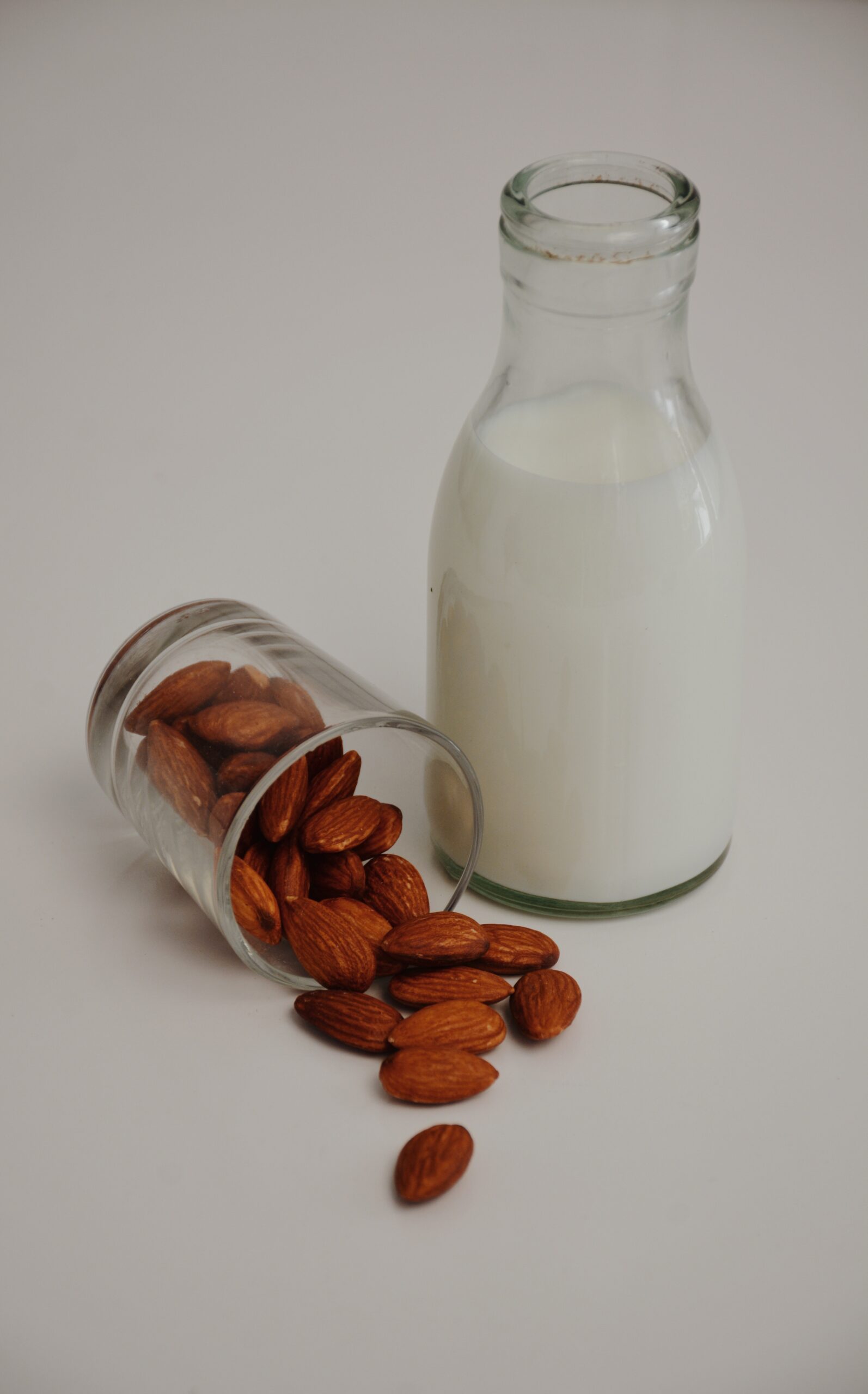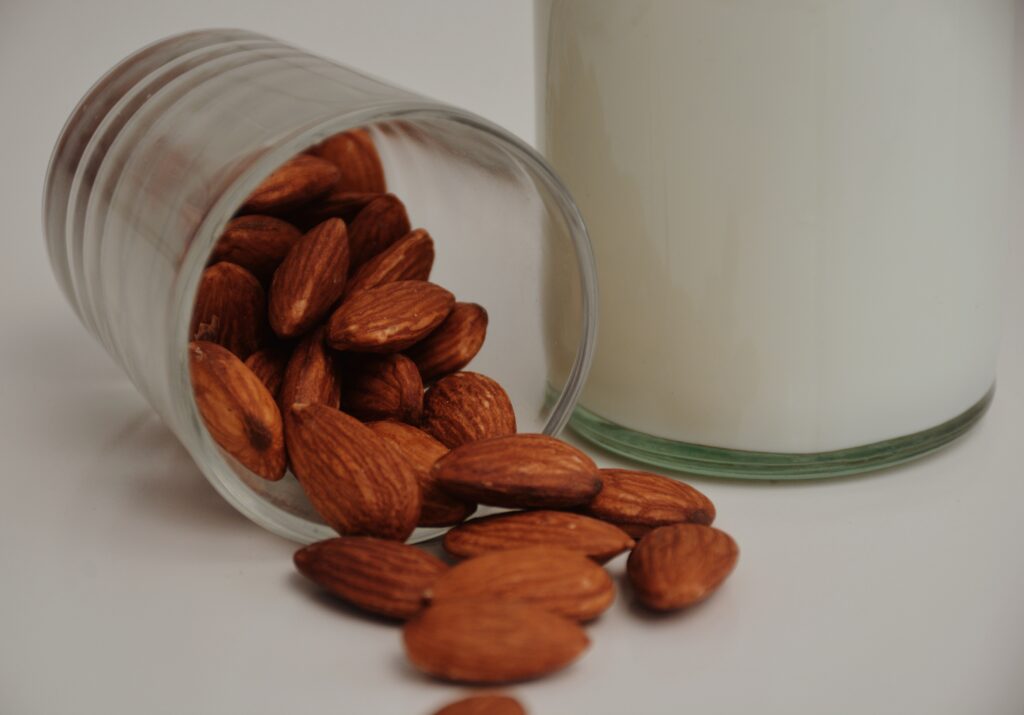
In recent years, almond milk has become an increasingly popular alternative to traditional dairy milk. But what does almond milk taste like, and how is it made? In this blog post, we’ll explore the taste of almond milk, how it’s made. Also we’ll discuss some of the health benefits of this milk alternative.
What does almond milk taste like?
Almond milk has a nutty flavor that sets it apart from regular cow’s milk. The taste of almond milk is often described as sweet and creamy, with a slightly grainy texture. The nutty taste and texture can make it a great addition to coffee, smoothies, and even boba tea.
Almond milk is available in both sweetened and unsweetened varieties. Sweetened almond milk has added sugar, which makes it taste sweeter than unsweetened almond milk. However, unsweetened almond milk has a more neutral flavor. It can be used in recipes that require milk without adding any sweetness.
Suggested: Can you Freeze Almond Milk? Here’s How
What Does Unsweetened Almond Milk Taste Like
Unsweetened almond milk has a more neutral taste than its sweetened counterpart. It has a nutty flavor, but it’s not as pronounced as in sweetened almond milk. Some people describe the taste of unsweetened almond milk as slightly earthy or grassy, with a mild sweetness. It has a slightly thinner texture than dairy milk. This can take some getting used to for those who are used to the thicker texture of regular milk.
What Does Sweetened Almond Milk Taste Like
Sweetened almond milk has a more distinct and pronounced sweetness compared to unsweetened almond milk. The sweetness can vary depending on the brand and amount of sugar added. But, it’s usually comparable to the sweetness of dairy milk. The nutty flavor is still present, but the sweetness can often overshadow it. Some people describe sweetened almond milk as having a similar taste to vanilla-flavored milk. The texture is also similar to dairy milk, with a creamy and smooth consistency.
What is The Texture Of Almond Milk
The texture of almond milk is generally smooth and creamy, with a slightly nutty flavor. It is typically thinner than cow’s milk and has a consistency that is similar to skim milk. When made at home or from certain brands, it may contain some small bits of almond pulp. This can give it a slightly grainy texture. However, most commercially produced almond milk is filtered to remove any pulp or solids. This results in a smooth and uniform texture.

How is almond milk made?
Almond milk is made by blending water with ground almonds and then straining out the solids. This process creates a creamy liquid that is similar in texture to dairy milk. Some recipes call for soaking the almonds overnight to make them easier to blend, but this step is optional.
Once the almonds are blended with water, the mixture is strained through a cheesecloth or nut milk bag to remove any remaining solids. The resulting liquid is almond milk, which can be used in recipes or enjoyed on its own.
Milk alternatives like oat milk and coconut milk are made in a similar way, but with different ingredients. Oat milk is made by blending water with oats and then straining out the solids. While coconut milk is made by blending water with shredded coconut and then straining out the solids.

Other Uses of Almond Milk Besides Drinking
Almond milk is a versatile and popular dairy-free alternative to regular cow’s milk. In addition to drinking it on its own, there are many other uses for almond milk in cooking and baking. Here are some of the most common uses of almond milk besides drinking:
- Baking: Almond milk can be used as a substitute for regular milk in many baking recipes. For example cakes, cookies, and bread. Just like these Raspberry Muffins!
- Smoothies: Almond milk makes a great base for smoothies, adding a creamy texture and nutty flavor.
- Coffee and tea: Almond milk can be used as a non-dairy creamer for coffee and tea. Adding a rich, nutty flavor. If you are looking to try other non-dairy options in your coffee, check this post about my Top 8 Non Dairy Milk Alternatives for Coffee. You can even froth almond milk for coffees and lattes! Here’s how to easily froth almond milk!
- Oatmeal: Almond milk can be used as a substitute for regular milk when making oatmeal, adding a delicious nutty flavor.
- Sauces and soups: Almond milk can be used as a creamy base for sauces and soups, adding flavor and texture without the added fat and calories of dairy products.
- Ice cream and popsicles: Almond milk can be used as a base for dairy-free ice cream and popsicles, providing a creamy texture and nutty flavor.
- Boba drinks: Almond milk is a popular ingredient in boba drinks, providing a nutty flavor and creamy texture.
Almond milk is a versatile ingredient that can be used in a variety of recipes and dishes. Its nutty flavor and creamy texture make it a popular choice for both sweet and savory dishes. It’s a great alternative to dairy milk for those who are lactose intolerant or allergic to dairy products.

Health benefits of almond milk
Almond milk contains several nutrients that are beneficial for our health. It’s a good source of protein, which is important for building and repairing tissues in our bodies. Almond milk also contains calcium, which is essential for healthy bones and teeth. In fact, some brands of almond milk are fortified with even more calcium than regular milk.
Another benefit of almond milk is that it’s low in calories compared to regular milk. One cup of unsweetened almond milk typically contains only 30-40 calories, while the same amount of regular milk contains around 100 calories. This makes almond milk a great option for people who are watching their calorie intake.
Additionally, almond milk is lactose-free, which means that people who are lactose intolerant can still enjoy the taste of milk without any negative side effects. It’s also a vegan-friendly option for people who want to avoid dairy products.
Is Almond Milk Good for Cholesterol?
Almond milk is generally considered to be good for cholesterol levels. Unlike dairy milk, which contains saturated fat that can raise cholesterol levels, almond milk is naturally low in saturated fat and cholesterol. In fact, studies have shown that consuming almonds and almond products, including almond milk, may have a positive effect on cholesterol levels.
Almonds are rich in monounsaturated and polyunsaturated fats, which can help to lower LDL or “bad” cholesterol levels while increasing HDL or “good” cholesterol levels. Additionally, almond milk is often fortified with vitamins and minerals, including vitamin E, which is an antioxidant that can also help to lower LDL cholesterol levels.
However, it’s important to note that not all almond milk products are created equal. Some almond milk products may contain added sugar or other ingredients that can be harmful to cholesterol levels. To reap the cholesterol-lowering benefits of almond milk, it’s best to choose unsweetened almond milk that does not contain any added sugars or other harmful additives.

Frequently Asked Questions About Almond Milk
Can You Whip Almond Milk
While it is possible to whip almond milk, it may not produce the same results as whipping dairy milk or cream. This is because almond milk has a lower fat content than dairy milk, which is one of the key factors that allows milk or cream to hold its shape when whipped. When attempting to whip almond milk, it is important to chill it first and use a whisk or electric mixer to incorporate air into the liquid. However, the resulting foam may not be as stable or voluminous as whipped cream or dairy milk.
Can You Heat Up Almond Milk
Yes, almond milk can be heated up. In fact, many people enjoy heating almond milk and using it as a dairy-free substitute in hot drinks such as coffee, tea, and hot chocolate. Almond milk can be heated on the stovetop or in the microwave, and it can be added to recipes that require heating, such as oatmeal or soups.
However, it is important to note that almond milk can curdle when heated to high temperatures or when it comes into contact with acidic ingredients. To prevent curdling, it is best to heat almond milk gently over low to medium heat and avoid boiling it. It is also recommended to stir the almond milk continuously while heating it to distribute the heat evenly and prevent scorching.
How to Thicken Almond Milk
Almond milk is naturally thinner than dairy milk, but there are several ways to thicken it if you need a thicker consistency for a recipe or for personal preference. Here are a few methods:
- Cornstarch or arrowroot powder: Mix a tablespoon of cornstarch or arrowroot powder with a tablespoon of cold water until it forms a slurry. Heat up the almond milk in a saucepan until it starts to simmer, then add the slurry and whisk continuously until the mixture thickens.
- Chia seeds: Chia seeds can absorb liquid and create a gel-like texture. Add a tablespoon of chia seeds to a cup of almond milk and let it sit for a few minutes to thicken.
- Oat flour: Mix a tablespoon of oat flour with a tablespoon of cold water until it forms a slurry. Heat up the almond milk in a saucepan until it starts to simmer, then add the slurry and whisk continuously until the mixture thickens.
- Reduce the almond milk: Heat up the almond milk in a saucepan over low heat and simmer it until it reduces by about a third to a half of its original volume. This will concentrate the flavors and thicken the texture.
- Commercial thickeners: You can also use commercial thickeners like agar agar, xanthan gum, or carrageenan to thicken almond milk. However, it’s important to follow the instructions on the package carefully as these thickeners can have different properties and may require different amounts.
Note that some of these methods may alter the taste or texture of the almond milk, so it’s best to experiment and see what works best for your recipe or personal preference.
In conclusion
Almond milk has a nutty taste and creamy texture that sets it apart from regular dairy milk. It’s made by blending water with ground almonds and straining out the solids. Almond milk is available in both sweetened and unsweetened varieties, and can be used in a variety of recipes. Some of the health benefits of almond milk include being a good source of protein, calcium, and being low in calories. So whether you’re lactose intolerant, vegan, or just looking for a healthier alternative to regular milk, almond milk is definitely worth a try.

Christopher is a food and lifestyle expert, recipe developer and the content creator behind May Eighty Five. With years of experience in the kitchen, he also shares tips, tricks and how to’s that he has learnt over the years. Every week, he shares quick, simple and mostly healthy recipes along with some home and entertaining tips. You will find flavorful cocktails, delicious appetizers, tasty mains and some indulgent desserts. As a home decor enthusiast, he also likes to share simple DIY projects and simple tips for a beautiful home.







11 Comments